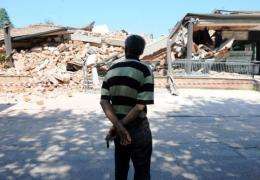Double quake highlights Italy's seismic perils

Two killer earthquakes that struck northeastern Italy in nine days have shed light on the brutal but complex seismic forces that grip the Italian peninsula, scientists say.
Brian Baptie, a seismologist with the British Geological Survey (BGS), said the worst earthquakes in Italy occurred in the south of the country, which lies close to where one of Earth's tectonic plates is sliding under another.
Farther north, earthquakes may be triggered by collisions in the south or by complex faults running through the Apennines, the mountainous "spine" of Italy, he explained.
"Southern Italy sits at a plate boundary. The boundary between the African plate and the Eurasian plate runs through the Mediterranean Sea just south of Italy," Baptie said in a phone interview from Edinburgh.
"The African plate is being subducted under the European plate, so that's why you get volcanoes like Etna and Vesuvius in southern Italy and why you get bigger earthquakes down there.
"Further north into Italy, earthquakes are still caused by that collision, but there are also more complicated things going on as well.
"You get the Apennine mountains running down the north-south axis of Italy, there are fault systems that run all the way through those mountains and they generate earthquake activity as well."
The big mischief-maker in northern Italy -- and also in the western Balkans -- is Adria, a microplate that covers the Adriatic Sea and is also sliding beneath the European plate.
On its website, the US Geological Survey (USGS) said Adria "greatly complicated" seismic activity in northern Italy, contributing to a compression of the northern end of the Apennine chain.
At least 15 people were killed on Tuesday by tremors measuring up to 5.8 magnitude that struck a region east of the city of Palma.
On May 20, a 6.0-magnitude quake in the same region killed six people and reduced homes and historic buildings to rubble. It has been followed by hundreds of tremors.
Baptie said it was "entirely possible" that the May 20 earthquake had set off the May 29 event.
"We know that when there are large earthquakes, stress is transferred to other fault systems and that in turn can trigger an earthquake on that fault as well." he said.
In May 2009, a 6.3-magnitude quake devastated the city of L'Aquila in central Italy, killing some 300 people and leaving tens of thousands homeless.
(c) 2012 AFP
















